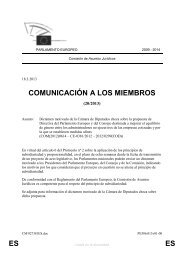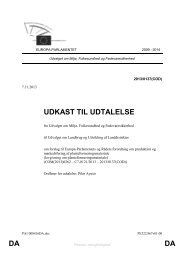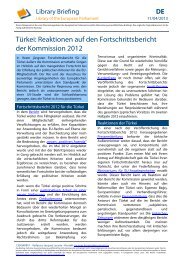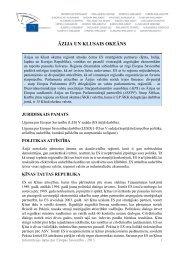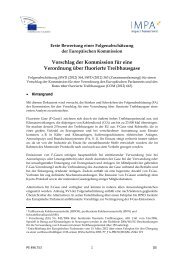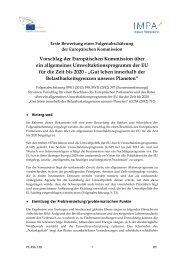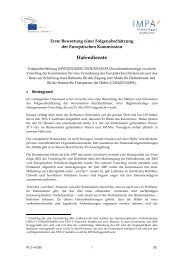Link to the study - European Parliament - Europa
Link to the study - European Parliament - Europa
Link to the study - European Parliament - Europa
You also want an ePaper? Increase the reach of your titles
YUMPU automatically turns print PDFs into web optimized ePapers that Google loves.
Policy Department D: Budgetary Affairs<br />
____________________________________________________________________________________________<br />
Part of <strong>the</strong> staff is still involved in<strong>to</strong> operational activities. Simultaneously <strong>the</strong> decommissioning work<br />
occurred and required an adaption <strong>to</strong> <strong>the</strong> new skills by personnel. A general safety policy was<br />
established in 2010 where <strong>the</strong> strategy of <strong>the</strong> decommissioning works is described.<br />
The training programs were modified <strong>to</strong>wards decommissioning works and <strong>the</strong> composition of <strong>the</strong><br />
work force was adapted. The training of dismantling staff is partly carried out by internal forces and<br />
partly executed by external forces. The training for <strong>the</strong> staff in <strong>the</strong> training centres involves both<br />
'hardware' - technical as well as soft skills training.<br />
The adaptation <strong>to</strong> <strong>the</strong> decommissioning task also involved psychological aspects. The first<br />
decommissioning activities started in 2001. The reorganization occurred only later in 2010-2011. The<br />
first phase can be characterized as a 'frustration period', among <strong>the</strong> staff but as well among <strong>the</strong> whole<br />
region around Ignalina being economically and socially strongly depending from <strong>the</strong> nuclear power<br />
plants. The task of decommissioning had <strong>to</strong> be established over this period. Meanwhile, <strong>the</strong> work<br />
force and <strong>the</strong> region accepted <strong>the</strong> decommissioning as <strong>the</strong>ir prime task.<br />
Ano<strong>the</strong>r fac<strong>to</strong>r is that decommissioning requires a very different organization structure and job<br />
understanding than in <strong>the</strong> operational phase. The original <strong>to</strong>p down hierarchy of <strong>the</strong> operation<br />
phase, more driven by handbooks, guidelines and well-established routine work, has <strong>to</strong> be<br />
exchanged by a more project-oriented approach, non-routine work governs <strong>the</strong> process and<br />
problem-solving capabilities are required instead. The adaption process is still under development<br />
and new and old structures still exist, but are more and more exchanged.<br />
About 5 000 people were employed in <strong>the</strong> time of <strong>the</strong> operation. Currently, about 2 000 employees<br />
are involved in<strong>to</strong> <strong>the</strong> decommissioning – with about 95 % <strong>the</strong> same personnel. New experts are<br />
employed if <strong>the</strong>y are needed.<br />
Safety culture indica<strong>to</strong>rs – quantitative and qualitative – had already been developed and<br />
implemented in <strong>the</strong> operation phase and are now adapted for <strong>the</strong> decommissioning phase. The long<br />
continuity behind those indica<strong>to</strong>rs is seen as a clear advantage. A regularly bench marking of <strong>the</strong><br />
safety culture takes place.<br />
----------------------------------------------------------------------------------------------------------------<br />
Administrational aspects<br />
Was it necessary <strong>to</strong> majorly change <strong>the</strong> internal administrational structure <strong>to</strong> adapt it <strong>to</strong> <strong>the</strong> new task?<br />
Did you encounter frictions in that change process?<br />
Are major administrational changes ahead <strong>to</strong> improve <strong>the</strong> structures?<br />
Technical aspects<br />
Which safety status has <strong>the</strong> facility reached? What has <strong>to</strong> be done technically <strong>to</strong> reduce safety risks fur<strong>the</strong>r?<br />
Which technical challenges were encountered so far in <strong>the</strong> project? How did those influence costs and time<br />
frame?<br />
Have lessons been learned by technical challenges so far?<br />
Which technical challenges do you see currently and in <strong>the</strong> near future? How are you preparing for those?<br />
162




